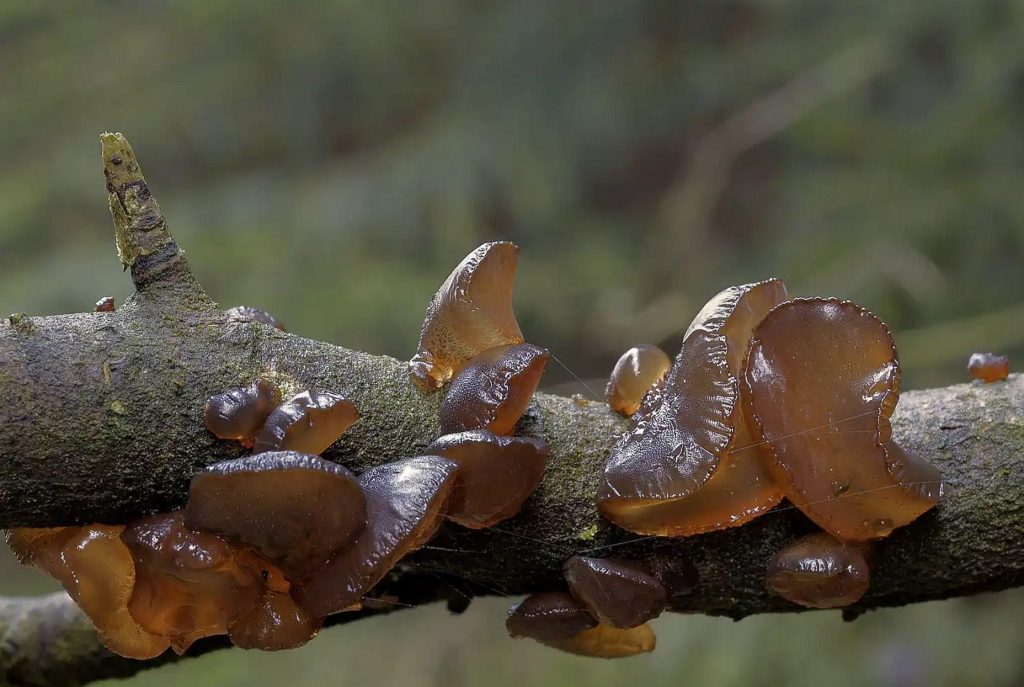Exidia recisa, more commonly known as the Amber Jelly Roll or Willow brain, is a reddish brown or amber, cone or ear-shaped, jelly-like/gelatinous mushroom whose individual fruiting bodies can be found discretely attached to dead or living branches and trunks of various hardwood trees after early spring rains.[i]
This species was first described in 1813 by a relatively unknown German mycophile L.P.F Ditmar who found it growing on willow twigs and named it Tremella recisa (meaning “of willow”). Soon after, the great Swedish mycologist Elias Magnus Fries published his Systema Mycologicum in 1821-1822 in which he reclassified this species under its currently accepted scientific name, Exidia recisa.
The etymology of this species’ name is relatively straightforward. The epithet “recisa” means “cut-off”, which is a reference to the shape of its fruit body.
Readers may also encounter this species under one of its older names Tremella recisa or Tremella salicum.
Identification and Description[ii]
Exidia recisa does not have the typical morphology of mushrooms. Instead, its fruiting body is a gelatinous/jelly-like mass with concave depressions and ridges. The fruiting bodies of this specie grow individually, however, they frequently cluster together and form larger fruiting masses.
Fruiting body: E. recisa has individual fruiting bodies that measure approximately 1-4 centimeters in diameter, but the coalesced fruiting masses can measure up to 10 centimeters or more. The fruiting bodies are lobular in shape, and are gelatinous but firm. The fruiting bodies also develop concave depressions that are separated by ridges, making the individual mushrooms resemble warts. The color of the fruiting bodies ranges from yellow-brown or amber-color to dark purple-brown. In dry conditions, the fruiting body may shrink, become much darker in color, and lose is gelatinous quality.
Stem: This species is most frequently sessile, however, it may sometimes feature a “pseudostem” which is essentially a pinched segment of the fruiting body at which point the mushroom attaches to its host.
Spores: E. recisa has smooth, allantoid (sausage-shaped) spores which measure approximately 10-15 x 2.5-3.5 µm in diameter. Their spores are hyaline in potassium hydroxide (KOH).
Spore Print: The spore print of this species is white.
Smell: This species does not have a distinctive odor.
Edibility: There is no clear answer to whether this species is edible, however, mycological sources seem to suggest that it is, having no distinct flavor. There are certainly no records of it being poisonous.
Habitat: Exidia recisa is a saprobic species, found growing in clusters on dead and decaying branches of hardwood trees. It is most commonly associated with willow and oak trees.
Range: Although this species can be found throughout North America, some sources suggest that it is more common in states east of the Rocky Mountains. It can also be found in Canada, mainland Europe, and the United Kingdom. [iii]
Fruiting Season: In the United States the fruiting season of E. recisa is from late fall to early spring.
Look-A-Likes[iv]
There are several other Exidia and Tremella species that E. recisa may be confused for.
Galanthus alpinus resembles E. recisa is shape. The latter can be differentiated based on its longitudinally septate basidia and lighter brownish-yellow coloration.
E. recisa may also be confused for Exidia glandulosa. The lack of a warty surface free from peg-like projections, a lighter coloration pattern, and a more erect, stem-like base can be used to differentiate E. recisa from E. glandulosa.
Exidia repanda is yet another similar species. It however has a more rounded and button-shaped fruiting body and is most commonly associated with Birch trees, and almost never with Willows.
References:
[i] Kuo, M. (2018, May). Exidia recisa.
[ii] First Nature. Exidia recisa – Amber Jelly.
[iii] Emberger, G. (2008). Exidia recisa.
[iv] McKnight, K. H., & McKnight, V. B. (1998). Exidia recisa. In A Field Guide to Mushrooms, North America (pp.66). essay, Houghton Mifflin.



